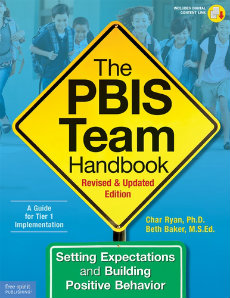Setting Expectations for Positive Behavior
The PBIS Team Handbook: Setting Expectations and Building Positive Behavior, Revised & Updated Edition
By Char Ryan and Beth Baker
(Free Spirit Publishing, 2019 – Learn more)

The PBIS Team Handbook is an excellent resource for schools that are ready to begin Tier 1 Implementation. The Handbook does an excellent job of giving a breakdown of what PBIS is, what it means to schools, and how effective it can be when implemented properly.
There are two parts to the revised edition: Part 1: What is PBIS and Part 2: Implementing PBIS Tier 1. The flow of the book is simple, direct, and explanatory.
Though most of the book focuses on getting the reader comfortable with all aspects of PBIS (Positive Behavior Interventions and Supports) and how to implement PBIS in schools, it does give a glimpse at how schools can begin to prepare for Tiers 2 and 3 of PBIS. One great feature that stood out to me was the section that provided a sneak-peak of each chapter. In this section, readers are able to read a few short sentences that highlight the main ideas in each chapter.

Organizing the PBIS leadership team
I particularly enjoyed the chapter about the PBIS leadership team. It set clear guidelines for roles, responsibilities, and tasks that are involved with a successful program.
You will find many reproducible documents that can be shared with staff such as Audit of Existing School Committees and Initiatives, PBIS Leadership Team Meeting Agenda, Team Meeting Checklist, and Routines for Conducting Effective Meetings.
Though there is a lot to read, there are many figures, charts, and graphs throughout the text for visual learners. There are coaching tips in each chapter to continually remind the reader that PBIS is an on-going process and to keep their eye on the school’s vision for PBIS.
Since data drives a lot of decision-making in school, it was imperative that the book take a deep dive into how staff can look at data. The PBIS Team Handbook takes readers through discipline referral data, assessment data, self-assessment surveys, and school-wide evaluation tools. Though there is a lot of information about data, co-author Beth Baker reminds readers to choose a few things that can be implemented rather than try to respond to everything the data reveals.
Getting staff buy-in
I really wanted to get my hands on this book to try to figure out how to get staff members to buy in on implementing a new strategy. I found the help I needed in chapter 6, where the authors discuss tasks, coaching techniques, and decision-making steps to achieve staff buy-in. There is an excellent reproducible document that allows staff to answer open-ended questions about current practices for behavioral problems, staff systems, student behavior, and even data practices.
This book really lets staff take a good, hard look at the systems they have in place. The reproducible worksheets provide a safe space for staff to reflect on what works, what doesn’t, and how things could be better.
As educators, we don’t want to make changes at the margins and just call our same old strategy a different name; we want real actionable steps and reliable sources that launch us on a new path. This book has what we need. It is real. It allows for reflection. It provides ways to implement PBIS so that educators can rip the band-aid off faulty school systems.
Christina Williams was born and lived in New Jersey for twenty-four years before she moved to Houston, Texas where she accepted her first teaching job. She currently lives in Middleville, Michigan with her husband Tom, their daughter Madalyn, and a crew of four-legged fuzzies. For the last five years she has worked at Covenant House Academy as an English teacher, Academic Interventionist, and Student Assessment Coordinator.




































